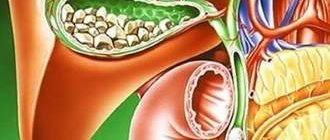Myasthenia gravis is a disease that is characterized by a violation of neuromuscular transmission (that is, a violation of the process of muscle contraction that occurs in response to an impulse traveling along a nerve fiber). The cause of myasthenia gravis is often an autoimmune process, as a result of which the body produces antibodies to the structures of the neuromuscular synapse. According to statistics, myasthenia gravis occurs in every 5 out of 100 thousand people. It is a chronic disease with acute or gradual onset. The main manifestation is transient muscle weakness; ptosis (drooping) of the upper eyelids, impaired swallowing, and a “nasal” voice may also occur. In severe cases and as the disease progresses, weakness of the respiratory muscles may occur, including respiratory arrest.
The dangerous disease progresses rapidly, clinical manifestations may subside and worsen again. Pathological muscle fatigue is diagnosed more often in women than in men, and much less often in children. The average age of patients is from 15 to 45 years, thus, the maximum number of cases is registered in the most active part of the population.
At CELT you can get advice from a neurologist.
- Initial consultation – 3,200
- Repeated consultation – 2,000
Make an appointment
Causes
Scientists identify two main causes of myasthenia gravis: congenital gene pathology and exposure to provoking factors.
The congenital form of the disease is associated with a mutation in the patient’s genome, as a result of which the transmission of information through synapses (special adapters that deliver impulses to their destination) stops. The acquired form of the disease occurs under the influence of the following provoking factors:
- Benign or malignant neoplasms;
- Autoimmune diseases (dermatomyositis, scleroderma);
- Inadequate physical activity;
- Constant stress;
- Viral diseases.
The mechanism of development of the disease is as follows: in the human body, the synthesis of special proteins begins, which destroy similar structures. This causes disruptions in the transmission of neuromuscular impulses. Myasthenic crisis develops under the influence of the following factors:
- Injuries;
- Stress;
- Acute infections;
- Some medications.
During pregnancy, symptoms of the disease in women may worsen or disappear.
Expert opinion
Author: Olga Vladimirovna Boyko
Neurologist, Doctor of Medical Sciences
According to the latest data, myasthenia gravis accounts for 0.5-5% of cases per 100 thousand population. Myasthenia gravis affects women 2-3 times more often. In most cases, the disease debuts before the age of 40. Patients with myasthenia gravis become disabled group 1 or 2 in 30% of cases. In Russia, the disease accounts for 2.5% of cases. The exact causes of myasthenia gravis are still unknown. Doctors identify predisposing factors, the presence of which increases the risk of developing the disease.
Diagnosis of myasthenia gravis can be delayed due to the variety of clinical manifestations. The Yusupov Hospital uses the latest equipment to examine patients: CT, MRI, EEG. To clarify the diagnosis, a serological blood test is performed in a modern laboratory. Thanks to an integrated approach, experienced doctors identify myasthenia gravis at any stage of development. An individual treatment plan is developed for each patient. This approach allows you to achieve positive results in a minimum amount of time.
Also at the Yusupov Hospital, relief of myasthenic crisis is available in intensive care and intensive care settings. The drugs used meet safety and quality standards.
What drugs are contraindicated
The following antimicrobial drugs are not prescribed to patients with myasthenia gravis:
- Aminoglycoside drugs: Netilmicin, Gentamicin, Streptomycin, Kanamycin, Monomycin, Tobramycin, Sizomycin, Amikacin.
- Marolids: Erythromycin, Doxycycline, Tetracycline and Azithromycin.
- Fluoroquinolones: Enoxacin, Ciprofloxacin, Ofloxacin, Norfloxacin, Lomefloxacin, Fleroxacin, Sparfloxacin.
- Anti-malaria drugs: quinines and chloroquinines.
- Uroseptics: Palin.
It is prohibited to take drugs to relieve seizures (Phenytoin and Carbamazepine), as well as neuroplegics (Sulpiride, Clozapine, Phenothiazines).
Patients with myasthenia gravis should not be prescribed drugs that affect the cardiovascular system:
- All beta blockers including Timolol eye drops.
- Alpha and beta blockers: Labetalol.
- Calcium channel blockers: Verapamil, Nifedipine.
- First class antiarrhythmics: Procainamide and Quinidine.
Saluretics are prohibited, namely: Furosemide and hypothiazides. However, Veroshpiron and other spironolactones can be used for treatment.
Neuromuscular blockers are contraindicated:
- Muscle relaxants (Relanium) and non-depolarizing muscle relaxants (Arduan and Tubocurarine).
- Centrally acting muscle relaxants that have a long-lasting effect: Baclofen and benzodiazepines.
- Local painkillers: Lidocaine.
- Botulinum toxin.
Other prohibited drugs include:
- Cuprenil.
- Alpha interferon.
- Magnesium preparations: magnesium sulfate, Panangin, Asparkam.
- Preparations containing radiocontrast agents based on iodine.
- Timazol, statins and Gabapentin are prescribed with caution.
Signs of the disease in adults
Clinical signs of myasthenia gravis may occur sporadically. The rest of the time the patient is in a state of remission (symptoms of the disease are not expressed). This is typical for the ocular form of myasthenia gravis.
You should make an appointment with a neurologist at the Yusupov Hospital if you have the following neurological symptoms:
- Rapid fatigue when chewing food, walking, working at the computer or reading;
- Violation of facial expressions, speech, voice;
- Motor function disorders.
At the onset of the disease, the clinical picture is so unexpressed that a person does not pay special attention to the existing abnormalities. Due to constant employment and heavy workload at home and at work, patients consult a doctor when the manifestations of the disease become noticeable.
Neurologists distinguish 3 groups of symptoms of myasthenia gravis in adults:
- Ophthalmic;
- Muscular;
- Respiratory.
Ocular manifestations of the disease include ptosis (drooping of the eyelid), diplopia (double vision), deviation to the side of the eyeballs when they move. As the load increases, the nervous symptoms worsen, the patient feels a headache and soreness in the eyes.
Muscular signs of myasthenia gravis are manifested by weakness in various muscle groups:
- Hypomimia – weakness of the facial muscles, when the patient has problems puffing out his cheeks, smiling, or closing his eyes;
- Bulbar syndrome - a swallowing disorder, which leads to the patient coughing while eating, choking, nasal during a conversation, and his speech becomes incomprehensible;
- Chewing weakness - the patient has difficulty chewing food, he gets tired quickly, and the disturbance in the eating process is aggravated by drooping of the lower jaw;
- Weakness in the neck and torso - it becomes increasingly difficult for the patient to hold his head, which tilts back or hangs down;
- Weakness in the limbs - due to the fact that the extensor muscles are predominantly affected, the patient experiences powerlessness after heavy exertion.
- Respiratory disorders are manifested by weakening of the muscles of the diaphragm, laryngeal and intercostal muscles. In this case, it becomes necessary to connect the patient to a ventilator. Patients are hospitalized in the intensive care unit around the clock, regardless of the day of the week.
Are there any complications?
The disease, due to a number of causative factors, can be complicated by crises of three types, provoked by bronchopulmonary infection:
- Myasthenic.
- Cholinergic.
- Mixed.
These types are characterized by a sharp worsening of the symptoms of the disease, impaired swallowing, and respiratory dysfunction. The patient is urgently placed in intensive care, connected to a ventilator (artificial pulmonary ventilation).
| A patient with signs of myasthenia gravis |
Forms of the disease
Neurologists distinguish the following forms of myasthenia in adults:
- eye;
- bulbar;
- Generalized;
- Myasthenic syndrome.
The ocular form of myasthenia is manifested by damage to the muscle fibers responsible for the movements of the eyeball, raising and holding the upper eyelid. These functions are disrupted with increasing physical activity, a stressful situation, and after taking anticholinesterase drugs.
The bulbar form of myasthenia is characterized by disturbances in the process of chewing food, swallowing, and speech. The patient's voice becomes hoarse and nasal. Since facial expressions are minimally expressed, it seems that the person looks much younger than his age. His smile resembles a grin.
In the generalized form of myasthenia, all muscles are affected. They are gradually involved in the pathological process. First, the movements of the eyeballs are impaired, then the function of the facial and neck muscles. After some time, the muscles of the musculoskeletal system are involved in the pathological process.
Myasthenic crisis can develop regardless of the form of the disease and the severity of movement disorders. The patient suddenly experiences double vision, severe weakness and impaired activity of the larynx. It becomes difficult for him to speak, breathe, and swallow. The pulse quickens. Salivation increases. In severe cases, the pupils dilate, the heartbeat quickens, and paralysis occurs with preservation of sensitivity.
A rare type of myasthenia gravis is Lambert-Eaton syndrome. The disease is characterized by disruption of neuromuscular transmission. This leads to fatigue, myalgia (muscle pain), paralysis of the extraocular muscle, and autonomic disorders. This syndrome develops in patients with small cell lung cancer and other malignant tumors. Patients often have difficulty rising from a sitting or lying position.
Myasthenia Gravis, or pseudoparalytic myasthenia, develops against the background of dysfunction of the endocrine system and autoimmune diseases - lupus, rheumatoid arthritis. It comes in the following types: congenital, newborn, juvenile, generalized adult myasthenia.
Make an appointment
Symptoms
The main symptoms of the disease are ptosis (drooping eyelids), weakness of the eye muscles, causing double vision. After even a slight load, muscle fatigue sets in. Weak muscles “behave” differently. Sometimes this symptom is pronounced, the disease worsens, and sometimes the patient’s condition improves. Myasthenia gravis, accompanied by severe attacks, is characterized by the appearance of paralysis, but this does not threaten sensitivity: no disturbances occur.
| Severe eyelid ptosis |
The main symptoms of the disease also include:
- problems with vision (focusing, perception of colors, shape of an object, the ability to assess the distance/proximity of objects, the appearance of a veil before the eyes suffers);
- respiratory dysfunction;
- rapid weight loss;
- transformed gait;
- speech disorders, altered voice (hoarse, hoarse, rough, the patient speaks quietly, “in the nose”);
- insomnia;
- difficulty and fatigue when chewing/swallowing/speaking;
- problematic swallowing of food in liquid form or puree (often because of this, aspiration pneumonia develops);
- myasthenic crisis, which is a prerequisite for death;
- psychomotor agitation;
- autonomic disorders;
- hypoxic brain damage (lack of sufficient oxygen) causing death;
- impaired motor skills of the fingers and toes, and in general of the upper and lower extremities;
- constipation or, conversely, diarrhea;
- paroxysmal palpitations.
The early stage of the disease is characterized by rapid recovery of the patient's body after rest. Over time, the symptomatic picture will be present, despite the patient's attempts to relax and rest.
Inattention to the symptoms that appear can lead to a state of noticeable muscle weakness (especially the muscles of the respiratory system), which is life-threatening.
Infantile myasthenia gravis
Symptoms of myasthenia gravis in children differ from those in adults. Congenital myasthenia is determined already at the stage of intrauterine development of the fetus: it is almost or completely inactive. After birth, due to the fact that the child cannot breathe, he dies. Neonatal myasthenia is manifested by the following symptoms:
- Lethargy;
- Difficulty breathing;
- A weak cry;
- Fatigue quickly.
- The baby quickly sucks milk. His mouth is constantly slightly open, his eyes are fixed, and swallowing is difficult.
Early childhood myasthenia is diagnosed in children under two years of age. Symptoms of the disease are similar to those of myasthenia gravis in adults:
- drooping eyelid;
- Gaze paralysis;
- Strabismus.
When the respiratory muscles are involved in the pathological process, the child becomes passive. If the masticatory muscles are affected, he may refuse to eat completely.
Childhood and youth myasthenia gravis affects children aged two to ten years. The disease is more often detected in girls. The symptoms are similar to the early childhood type of the disease. The difference lies in diagnosis: it is easier to ask an older child about symptoms, which allows for therapy to be started sooner.
Autoantibodies associated with MG
Among patients with MG, antibodies to nicotinic acetylcholine receptors (AcChRs) of muscle tissue are most common. Nicotinic AcChR is a transmembrane pentameric glycoprotein weighing 250 kDa, consisting of two α1-, one β1-, one δ- and another γ- (in embryos) or ε- (in adults) subunits. These subunits form a channel that, when acetylcholine binds to the two α1 subunits, opens the flow of Na+, Ca2+ and K+ across the cell membrane. Anti-AChR antibodies are detected in 80% of patients with MG. These antibodies are polyclonal, can bind to the corresponding receptors and block them, leading to internalization and degradation of receptor structures, and also activate the complement system, forming a membrane attack complex. Antibodies are formed to specific acetylcholine binding epitopes. In the case of autoaggression against α1-subunits, the severity of the disease will be much more pronounced.
MuSK is a transmembrane protein consisting of one subunit, the function of which is to structure AcChR and bind it to rapsyn, a protein that serves as a bridge between the receptor and the cytoskeleton. MuSK is activated after phosphorylation induced by the LRP4-agrin complex, after which AcChR clustering occurs.
Anti-MuSK antibodies are detected in 1–10% of cases. They primarily bind to the immunoglobulin-like tyrosine kinase domain. Most of these antibodies belong to the IgG4 subclass, which makes complement activation and antigenic modulation impossible, since anti-MuSK is functionally monovalent, and for antigenic modulation it is necessary to bind 2 molecules to the antibody. Thus, the negative phenomenon of secretion of these antibodies is manifested by the overlap of the MuSK binding site, preventing its activation through LRP4 and collagen (ColQ). As a result, there is a decrease in the density of AcChRs on the postsynaptic surface and a disruption of their location.
LRP4 is a single-subunit transmembrane protein with a large extracellular domain containing multiple low-density lipoprotein repeats. As described above, the association of LPR4 with agrin causes the activation of MuSK. Anti-LPR4 antibodies are not strictly specific for MG. In 10–23% of cases, they are also found in patients with amyotrophic lateral sclerosis.
Agrin binds to muscle membrane proteins such as LRP4, dystroglycan and laminin, structuring the neuromuscular junction that supports and promotes regeneration. Agrin autoantibodies inhibit MuSK phosphorylation, likely through suppression of LRP4-agrin complex formation.
Collagen Q (collagen tail of acetylcholinesterase, ColQ) concentrates and retains acetylcholinesterase, which promotes the degradation of acetylcholine, in the extracellular matrix of the neuromuscular junction. Anti-ColQ antibodies are detected among 3% of patients with MG and in 2.3% of healthy people (not patients with MG). Mutations in the gene encoding ColQ also lead to diseases, one of the syndromes of which is myasthenia gravis. The exact pathophysiological aspect of the development of MG due to the secretion of autoantibodies to ColQ is unknown.
Antibodies to voltage-dependent potassium channels of skeletal muscles Kv1.4 were detected in Japanese and European groups of patients with MG in 10–20% of cases. Also, among only the Japanese group, cardiac arrhythmias were observed due to the presence of Kv1.4 in the endocardium.
The presence of antibodies to intracellular proteins is an aggravating prognostic factor regarding the severity of MG and the presence of thymoma. These intracellular proteins include tintin, cortactin and ryanodine receptors.
Tintin is an essential component of muscle contractions. Anti-Tintin antibodies are detected among 20–30% of patients with anti-AChR antibodies, often with concomitant thymoma or with late onset of MG. Anti-Tintin antibodies are highly sensitive and specific markers of thymoma.
Cortactin binds to actin in skeletal muscle, promoting its assembly as well as AChR clustering. Antibodies to cortactin occur in 20% of cases among doubly seronegative patients with MG and in 5–10% of cases among patients with antibodies to AcChR. However, these antibodies can occur among healthy people (5%), as well as patients with other autoimmune diseases, including polymyositis (20%), which makes this marker unspecific for detecting MG.
Ryanodine receptors (RyR) are calcium channels of the sarcoplasmic reticulum. They open upon depolarization, allowing muscle contraction by releasing calcium from the sarcolemma into the cytoplasm. Anti-riadin antibodies are detected in 70% of patients with MG with thymoma and among 14% of patients with late onset MG. Antibodies to RyR can also be used as an indicator of thymoma and severe MG.
MG is often associated with thymoma. It is likely that autoimmune aggression is associated with impaired formation of peripheral tolerance as a result of thymic pathology. The mechanisms of the thymus are shown in Figure 3.
Figure 3 | The process of formation of normal immune tolerance
Recognition of autoantigens in the thymus is facilitated by multigene transcription factors such as AIRE (autoimmune regulator), which is expressed in the thymic medulla. AIRE results in the expression of essential peripheral proteins on the surface of thymic epithelial cells, after which T cells recognizing these proteins (or “autoantigens”) become targets of negative selection and undergo apoptosis. Autoreactive T cells that escape central tolerance migrate to the periphery, where they may undergo apoptosis, suppression, or enter a state of anergy (peripheral tolerance). Central and peripheral tolerance of T and B cells to autoantigens is critical to the survival and development of the organism. In MG, most patients have impaired central tolerance, which leads to the appearance of autoreactive cells. AChR - acetylcholine receptor; APC—antigen presenting cell; MHC—major histocompatibility complex; TCR—T cell receptor; Treg is a regulatory T cell.
Diagnostic methods
To establish an accurate diagnosis and find out the causes of nerve function disorders, neurologists at the Yusupov Hospital conduct a comprehensive examination of the patient. It includes:
- Patient interview;
- General and neurological examination;
- Palpation, percussion and auscultation;
- Neurological examination.
Doctors at the Neurology Clinic prescribe the following laboratory and instrumental studies:
- Clinical and biochemical blood test;
- Electromyography, which is used to assess muscle condition;
- Genetic screening to determine the presence of a mutation gene in a DNA chain;
- Electroneurography, which is used to check the speed of impulse transmission;
- Magnetic resonance imaging, which provides data on the presence of thymic hyperplasia and tumor-like neoplasms.
A fatigue rate test is also performed. The doctor asks the patient to quickly perform chewing movements with his jaw, swing his limbs, clench and unclench his hands, and quickly squat. When performing a protein test, a special substance is injected under the patient's skin. Within half an hour a person feels a significant physical lift. His fatigue goes away. This condition does not last long. After the drug takes effect, the symptoms of myasthenia gravis return.
The decrement test is a method for studying the process of transmission of neuromuscular impulses. It aims to study five muscle groups. Each of them is exposed to an artificial provocateur, causing rhythmic contraction of muscle fibers. For any form of myasthenia gravis, the response rate will be low.
To conduct a serological test, the patient donates blood 4 hours before eating to obtain serum. Laboratory assistants perform enzyme immunoassay. Using this test, antibodies to the acetylcholine receptor are detected in 90% of patients with myasthenia gravis.
The pharmacological diagnostic criteria include the proserine test. Doctors use proserin or kalimine forte to carry it out. In 15% of patients with myasthenia gravis, movement disorders are fully compensated during the procedure.
Make an appointment
Prevention
After diagnosis, you need to constantly monitor the course of the disease and regularly visit a neurologist. In addition to the indicated therapy, the doctor will monitor the general condition of the body.
The patient is prohibited from physical activity, as it can worsen health. You can't be in the sun.
It is extremely important to follow the specialist’s recommendations regarding taking medications.
Medical therapists and neurologists will do everything possible to treat the patient. If unusual symptoms appear, you should consult a doctor as soon as possible. You can make an appointment for a consultation in St. Petersburg by calling the phone number listed on the website.
Complex therapy
Neurologists at the Yusupov Hospital treat myasthenia gravis with the latest medications that are effective and have a minimal range of side effects. All medicines are registered in the Russian Federation. Thanks to the cooperation of doctors at the Yusupov Hospital with research institutes, patients at the neurology clinic have a unique opportunity to receive the latest drugs that are undergoing the last stage of clinical research.
Neurologists use the following pharmacological drugs to treat myasthenia gravis:
- Anticholinesterase drugs;
- Corticosteroid hormones;
- Cytostatics;
- Potassium salts.
In most cases, doctors at the Neurology Clinic choose a three-step treatment strategy for myasthenia gravis. It includes compensation of neuromuscular transmission, correction of autoimmune disorders, and effects on the thymus gland. Compensation for neuromuscular transmission is carried out with potassium preparations. They enhance the synthesis of acetylcholine. Medicines of this pharmacological group can be used at all stages of therapy. During long periods of remission, they are prescribed to prevent exacerbation.
Neurologists carry out pulse therapy with glucocorticoids when previous medications are ineffective, in preparation for surgery and to combat bulbar complications. The doctor calculates the dosage individually for each patient.
Cytostatics are used to influence the thymus gland. In case of crises or respiratory failure in the Yusupov Hospital, patients with myasthenia gravis undergo plasmapherosis sessions. One of the new therapy methods is cryopherosis. Using low temperatures allows you to cleanse the blood and get rid of harmful substances.
Also used to treat myasthenia gravis are immunosorption (extraction of antibodies from the blood), gamma irradiation of the thymus (exposure to the thymus gland by radioactive radiation), and physiotherapeutic procedures:
- Electrical muscle stimulation;
- Inhalations;
- Massage;
- Electrophoresis.
If conservative therapy is ineffective, surgeons perform a thymectomy - removal of the thymus gland. There are three main methods of performing this surgical intervention:
- Transternal – the thymus gland is removed through an incision in the sternum;
- Transcervical - removal of the thymus is performed through an incision at the base of the neck;
- Robotic surgery – surgery is performed using robotic manipulators.
75% of patients experience a significant improvement in their health after surgery.
Treatment
Treating myasthenia gravis is not an easy task. The patient should be immediately set up for constant or very long-term use of anticholinesterase drugs that act on the pathogenesis of the disease. Kalimin drugs, and the less commonly used proserin, should be carefully dosed, taking into account body weight, severity of symptoms, age and other factors. Hormone therapy is often resorted to, especially with acute development of symptoms and their rapid progression. Most often, pulse therapy is carried out in high doses, with a further transition to minimal dosages. It is also advisable to conduct sessions of plasmapheresis (purification of blood from circulating autoimmune complexes) while using pulse therapy with hormones (metipred, dexamethasone, etc.).
Treatment of myasthenic crisis should begin with maintaining vital functions, gradually moving to a course of plasmapheresis, hormonal therapy, and clarifying the presence of a thymic tumor. The presence of thymoma (especially growing) in combination with frequent myasthenic crises is an indication for surgical removal of thymoma. Unfortunately, only about 50% of patients report improvement.
Also, therapy for myasthenia gravis should include pure potassium preparations (in no case Panangin, because magnesium can lead to worsening of symptoms!), the prescription of potassium-sparing diuretics (veroshpiron), metabolic drugs (riboxin, B vitamins). The prescription of physiotherapy, special physical therapy exercises, and massage is justified.
List of drugs that cannot be used for myasthenia gravis
You should also strictly adhere to specific approaches to the treatment of other diseases. There is a list of drugs that cannot be used for myasthenia gravis:
Diet therapy and lifestyle correction
For patients with myasthenia gravis, neurologists prescribe special diet therapy. Its goal is to increase the protective function of the body. Dishes should contain large amounts of potassium, phosphorus, calcium and vitamins.
Fatty and fried foods, smoked foods, and canned foods are excluded from the menu. Patients are advised to stop drinking alcohol. Patients should also follow the following doctor's recommendations:
- To refuse from bad habits;
- Control body weight;
- Reduce time spent in direct sunlight;
- Avoid physical and emotional overload;
- Alternate work with rest.
Without consulting a doctor, patients with myasthenia gravis should not take the following medications: diuretics, fluoroquinols, tranquilizers, antipsychotics, drugs containing fluoride, magnesium, quinine.
Forecast
Myasthenia gravis is an incurable disease, however, the prognosis is conditionally favorable: with proper treatment, the patient can live a long time and at the same time maintain an acceptable quality of life. Currently, this disease is no longer considered fatal, and before the advent of effective treatments, about 70% of patients died. In the absence of treatment, the symptoms of myasthenia gravis progress, the process generalizes with the involvement of the respiratory muscles, which can cause death.
Myasthenic crisis
Myasthenic crisis is considered a complication of the disorder in question. This condition is characterized by sudden weakness of the muscles responsible for breathing and swallowing. Myasthenic crisis manifests itself in the form of the following symptoms:
- rapid and wheezing breathing;
- tachycardia;
- active salivation.
If a myasthenic crisis occurs, the patient requires emergency care. This condition causes paralysis of the respiratory muscles, which is life-threatening.
Myasthenia gravis tends to progress in most patients. The course of the disease is characterized by a sharp change in relapses and remissions. The development of myasthenic syndrome may stop for a while, but this is rare.
Exacerbation of pathology is episodic or long-term. In the first case, the symptoms of the syndrome subside quickly, after which the patient does not experience any problems with the functioning of the muscular system.
The long-term form of the disease (myasthenic state) is characterized by the appearance of all the symptoms characteristic of this type of disorder.
At the same time, there is no increase in the intensity of clinical manifestations. The duration of the myasthenic condition is often several years.










